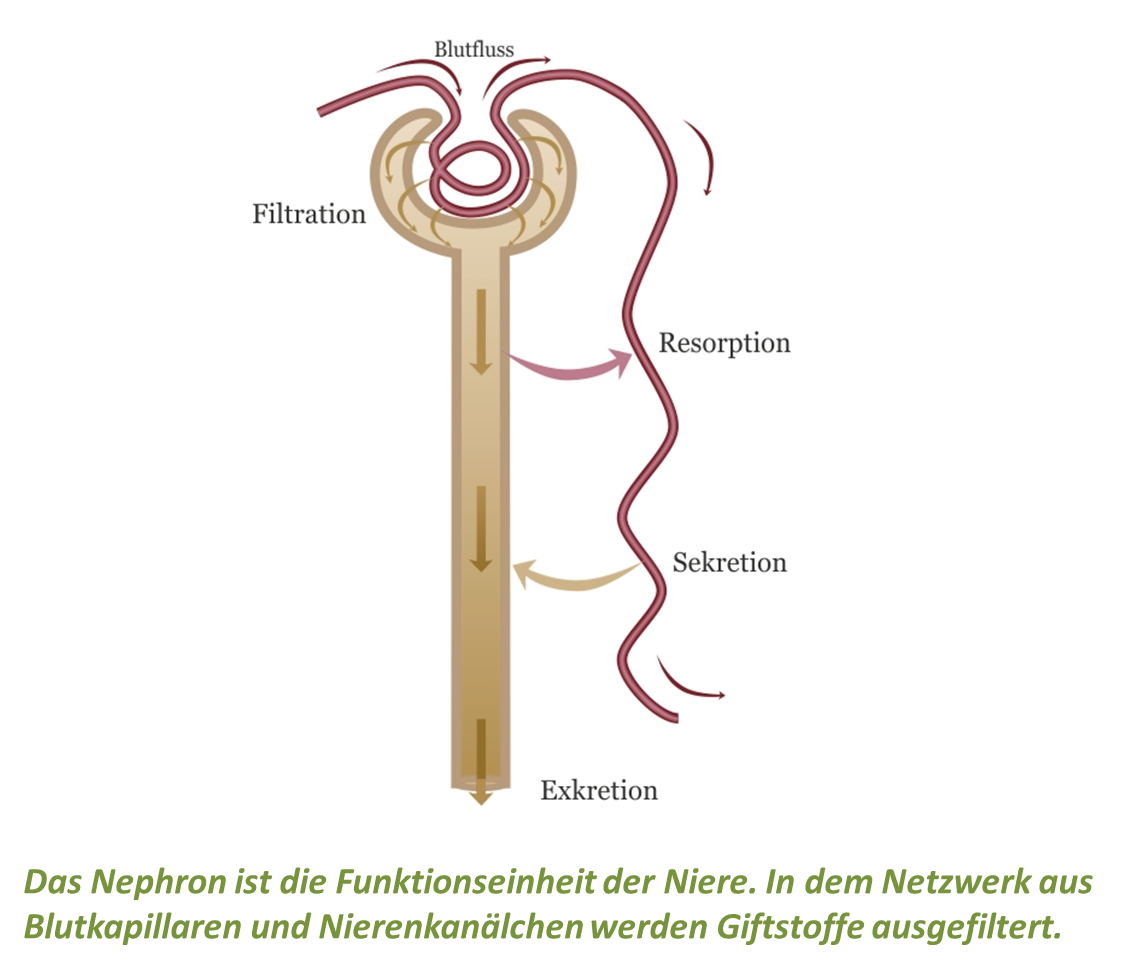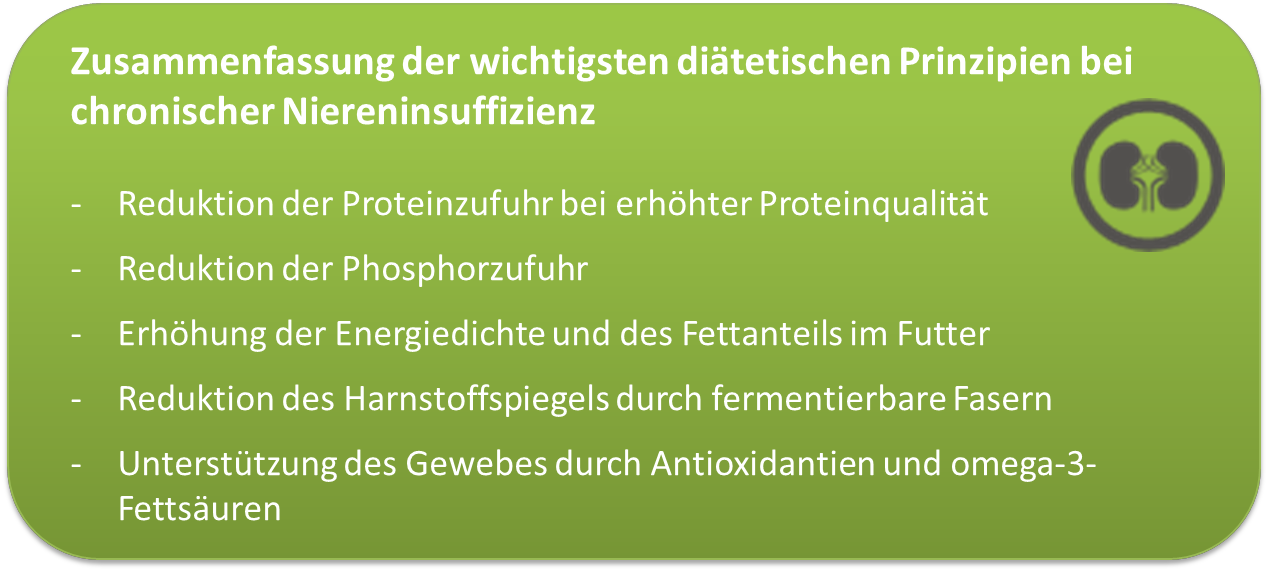About 4% of all dogs suffer from chronic kidney disease. These dogs usually suffer from reduced appetite, nausea, fatigue and chronic diarrhoea. In advanced cases, renal insufficiency can also lead to anaemia, neurological symptoms and cardiac dysfunction. Nutrition plays an important role in the treatment of this disease. But what does renal insufficiency mean for your dog's body and why does the diet have to be adapted?
Tasks of the kidney
The main tasks of the kidneys are the excretion of foreign substances and metabolic products as well as the preservation of substances that are important for the body. This is done through a mechanism of filtration, resorption and secretion that removes harmful substances from the body and retains useful substances in the body. In addition, the kidneys regulate the water and electrolyte balance of the body by, for example, excreting a large amount of aqueous urine when there is excess fluid, and only a small amount of a very highly concentrated urine when there is a lack of water. This ensures that the correct concentration of body fluids is maintained in the body.
Structure and function of the kidney
The implementation of these complex tasks is only made possible by the special structure of the kidney tissue. It consists of the so-called nephrons, which are composed of glomerules (capillary clusters of vessels) and tubules (tubes) (see figure).

In each kidney thousands of such nephrons can be found, which is connected with a large performance capacity. In fact, the dog's function is limited and clinical symptoms occur when more than 70% of the nephrons are destroyed. This limits the ability of the kidney to concentrate urine, leading to the first signs of renal failure: increased water absorption and increased urge to urinate.
Symptoms
Depending on the stage of the disease, the body is no longer able to excrete degradation products that accumulate in the blood. There is an increased accumulation of nitrogen-containing degradation products from protein metabolism, such as urea and ammonia. This so-called uremic syndrome is partly responsible for many of the possible symptoms of advanced renal insufficiency. These include reduced appetite, nausea, fatigue, electrolyte disorders and pH deviations, mucosal defects, weight loss and chronic diarrhea. In addition, anaemia, neurological symptoms and cardiac dysfunction can occur. Another problem is the disturbed metabolism of calcium and phosphorus, which can lead to demineralisation of bones and calcifications of various organs.
Once damaged, kidney tissue is not able to regenerate again. Such a kidney disease can therefore not be cured. It is therefore of particular interest to delay the progression of the disease and to increase the patient's well-being and life expectancy.
Adaptation of diet
Nutrition in particular plays a decisive role in the further course of the disease. The most important goal is to reduce the clinical symptoms as well as the biochemical and physiological consequences of the loss of function.

Reduction of protein consumption
In particular, a reduction of the protein intake is of great importance here in order to relieve the body of the breakdown products which are responsible for a large part of the complaints. The lowering of the protein content in the feed should be carried out depending on the blood values. A reduction to 8-11 g protein per 1 MJ energy is recommended. In advanced cases it may be necessary to reduce the protein content to 6 g/MJ. The meat content of the ration must therefore be reduced. In order to avoid deficiencies at this low level of protein intake, particular attention should be paid to the quality of the protein sources used, i.e. high digestibility and a favourable amino acid pattern.
Addition of fermentable fibres
In addition, the body can be relieved of the protein degradation products present in the blood circulation by adding so-called fermentable fibres to the food. These fructooligosaccharides (FOS) are vegetable components (e.g. in carrots or sugar beet pulp) which the dog cannot utilize itself, but which are used in the gastrointestinal tract as food for the bacterial flora that lives there. These bacteria can thus multiply and are able to break down urea from the bloodstream and thus relieve the dog's metabolism
Reduction of phosphorus supply
In addition to the breakdown products of protein metabolism, dogs with renal insufficiency also have problems excreting phosphorus. This accumulates in the blood, which leads to serious disturbances of the mineral and hormone balance. Here, too, it is necessary to limit the intake of food. In the advanced stage of the disease it may be necessary to add phosphate binders to the feed, which limit the absorption of phosphorus in the intestine. These measures delay the progression of the disease and lead to a longer survival time of the patients.
Adjustment of mineral and vitamin intake
Other nutrients that need to be adapted to the impaired kidney function are sodium and water-soluble vitamins. Sodium has a similar problem to phosphorus. Excretion is disturbed and elevated blood levels can lead to further complications, such as high blood pressure. It is therefore important to choose a food that does not contain sodium in excess of what is required. The opposite is true for vitamins. These are more or less "flushed out" of the body, so the supply should be adjusted for kidney patients.
Increase in the fat content of the feed
Fat metabolism also suffers from disorders which can be compensated by increasing the intake of unsaturated fatty acids, in particular omega-3 fatty acids (e.g. from fish or linseed oil
). These fatty acids also have a positive effect on the kidney tissue directly, as they can fight inflammations. Antioxidants such as vitamin E also protect the kidney tissue by intercepting harmful radicals.
Increasing the energy density in the feed
In addition to these nutrient adaptations, care should ultimately be taken to ensure that the dog absorbs sufficient energy to prevent body mass loss. It may be necessary to stimulate the appetite, for example by warming up the food. Regular checks should also be carried out by the veterinarian in order to be able to make any adjustments to the feed. If all these nutrition advices are considered, the best basis is created to enable affected dogs to live as long as possible and with as few complaints as possible.

